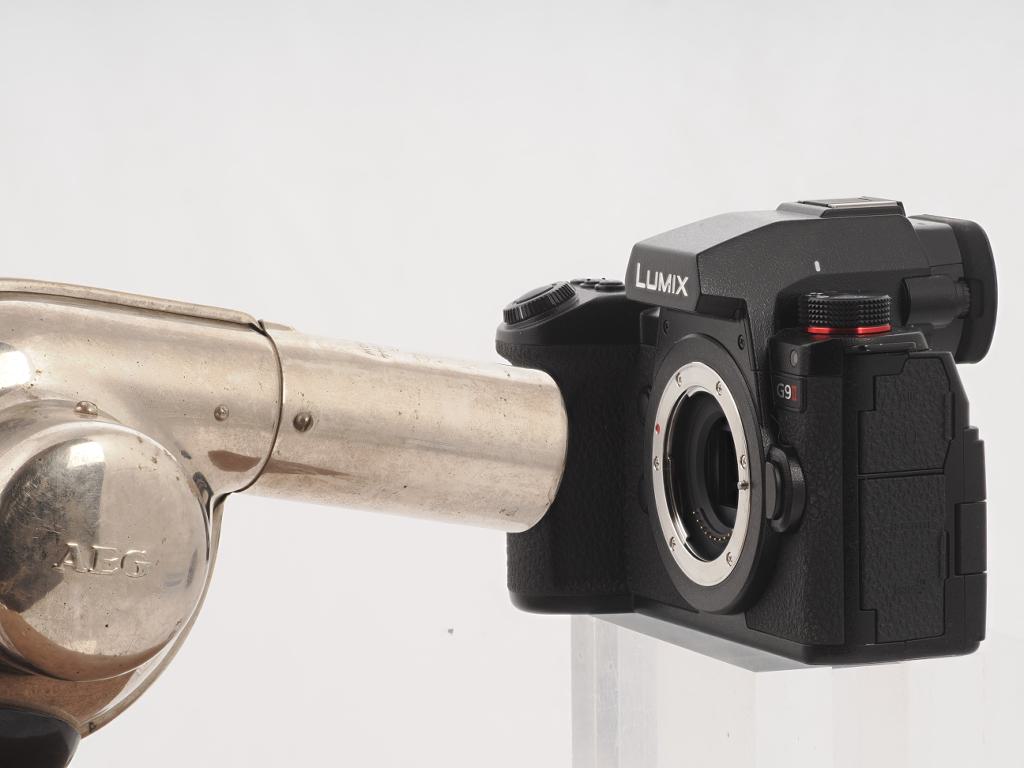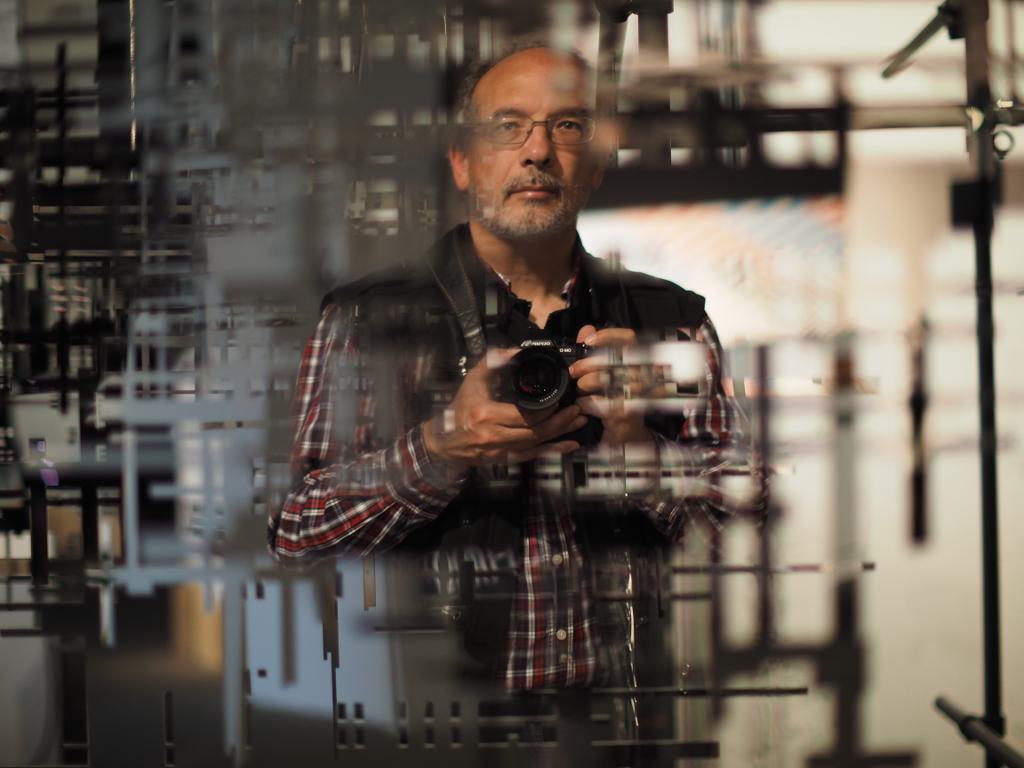
A few days ago, I photographed a family celebration with the G9II on assignment and made the bad mistake of not taking an Oly with me. The family patriarch was sitting there and I had a camera in my hand that was either out of focus (most of the time) or brutally sharp. Neither of the two results is presentable on location. “Look grandma, the great photographer took your picture, want to see?” I won’t win a flower pot with the pictures from the G9II. (“My cell phone does that better”)
With the OM-1 I put a soft focus on it and then I can show the pictures to my granny and she thinks it’s good. It doesn’t look as ironed as on a smartphone, but it’s not so brutal that you want to call the undertaker and order your own coffin. So it’s just right.

At seminars, I’ve always said that I would never buy another camera that didn’t have an ArtFilter “soft focus” in it. That was always meant half in jest. Now I’m deadly serious about it. You can chase young people with it – they think it’s tacky (and if you then say “no problem, let’s delete it and make it sharp”, they say “no, it’s fine” and then secretly put the picture on their mobile phone). But as soon as you start shooting people on the stupid side of 50, the soft focus has to be in the camera.
But the G9II has such great “LUTs” that you can load onto the camera? Yes. These are colour substitution tables. Apart from the fact that Panasonic doesn’t provide any tools to build these LUTs, you can use them to replace colours and generally adjust brightness. But not micro-contrast compensation, for example. The art filters are a different matter. But can you do it afterwards, on the PC….? Sure, but what if someone wants to see something on site? People are used to being able to see results immediately. And results that look good. After all, everyone has smartphones.
And I’ve been travelling with the OM-1 again over the last few days. Misfocus? Nope. C-AF on the dot, model aeroplanes in storms – these things get fast – no problem at all. Bad light, backlight, brutal wind and long focal lengths, dark surroundings, FTs, the whole programme. The OM-1 delivered. Just like that. And when I took continuous shots, the buffer was immediately free again – no comparison with the G9II, where you just wait and pray that nothing happens in the next minute that you have to take a picture of. (Although that wouldn’t matter, because with the G9II you can also take pictures while the buffer is still being written away. But you can’t control the images while the buffer is still being written). (Yes, the OM-1 can of course also write to the buffer while it is being pushed onto the card.)
Hauke Fischer has written two blog posts on the subject of image quality (here and here) where he claims that it makes no difference what you run around with, as long as you know your tools. (And by the way, he also mentions Olympus as a camera company that knows how to remove practical functions from the camera). In principle, of course, I agree with him. All this AI stuff is not conducive to good images in the current state of the art. If I take care of the image statement and photograph carefully, I don’t need an AI autofocus that recognises and focuses on a girl from behind. (Incidentally, it’s quite funny in the advertising videos (!!!) for the OM-1II, where the “AI” reliably recognises an eye of the girl turning around, but stupidly just any eye and not necessarily the eye closest to the camera. Which is quite a fail. Because either the depth of field doesn’t reach through the face – in which case the focus on the wrong eye is a ruined image – or the depth of field is sufficient, in which case all the eye recognition is for the feet….) But the OM-1 does make a difference, especially in the area where I shoot.
Sure, it may be that the Sonys can do it all better. I had a few Sonys in my hands and should write a book about them. You can see the results here. The Sonys are ugly, the new versions are mainly firmware updates and the “Global Shutter Bolide” is purely a marketing thing. (And Sony’s marketing people are also too stupid to understand their own texts: “the Alpha 9 III achieves a maximum shutter speed of 1/80,000 sec.”. If that’s the maximum shutter speed, then I wonder what you want to photograph with the camera – apart from the surface of the sun) And just to kill the myth of the “ideal sports camera”. A sports camera shoots the images directly onto the server. A dispatcher sits there and immediately pushes the images for sale. If someone comes along and shoots every scene of an international match at 120fps, the dispatcher will come to the edge of the pitch during the half-time break and cut the photographer’s head off. If you can’t take pictures, then you should leave it at that or at least not annoy other people with it. The OM-1 also does 120fps. For years now. I shoot sports at a maximum of 25fps. Usually less. Someone has to sift through it and send it to the editors in time. (Again, it’s interesting to hear the hymns of praise from the “specialised press”, who are afraid that they will no longer be supplied with advance copies by the manufacturers).

Trying to combat the “feature crisis” with AI is nonsense. Does the camera know what I want to photograph? No. The whole AI approach to innovative photography is doomed to failure from the outset. AI in photography is trained by mass taste. You can take photos that thousands of others have already taken. Nobody has photographed chickens, so the cameras fail on chickens. (The G9II is no exception.) Millions of photos have been analysed to create an automatic white balance that always fits. But it just doesn’t work for photos that don’t occur in millions.
The problem: if a million photographers have already snapped sea eagles with a fish in their mouth – where is the point of being the millionth? You can pave the streets with penguin photos and the CO2 emissions of the fleet of penguin-photographer luxury expedition steamers now equals that of 5 million cars.
Has everything already been photographed? No. There are houses that were never properly photographed before they were demolished. There are people who weren’t photographed because people thought they could save the money for a decent photographer and then the people are dead. There are millions of things that have meaning. And that AI has no idea about.
That’s why we’re human. And if we do what the AI wants, then the AI can replace us.
Cover picture: Sensor cleaning on the G9II according to the manual instructions. Take a standard hair dryer…
BRAVO!
Gruss
ours
Sehr gut auf den Punkt gebracht.
Liebe Grüsse, Gerhard O
Die E-M1 II bekam per Update nachgereicht, dass die Tasten beim Wegspeichern des Puffers funktionieren. Bei der E-M1 viel mir das nicht negativ auf, erst bei der E-M1 II. Vielleicht konnte die Ur-E-M1 das aber auch. Die OM-1 II soll angeblich auch das Speichern in einen nur teilentleerten Puffer ernöglichen. Habe ich leider nicht bei der Vorstellung in Berlin am 01.02. getestet.
Viele Grüße
Frank
Auch bei der OM-1 kann man natürlich in den teilentleerten Puffer fotografieren. Um Himmels Willen – wenn das nicht ginge…..
Beruhigend 😉
Bei der E-M1X kann ich den Vorgang der Speicherkartenzugriffsanzeige (Symbol rote Speicherkarte mit Pfeil) einfach durch einen Durck auf den Auslöser unterbrechen. Bei der E-M1 II hatte das ja anfangs leider nicht geklappt und man durfte warten, bis das Symbol von allein verschwand. Mich hat daher erstaunt, dass das an anderer Stelle nun erneut für die OM-1 II diskutiert wurde. Dachte daher, auch nach der Beschreibung dieses Vorgangs von Dir hier in Bezug auf die G9II, dass die OM-1 da ebenfalls zickig war.
Dankeschön für die Klarstellung
Frank
Hallo Reinhard, Du hast mir etwas zum Schmunzeln an einem regnerischen, grauen Tag beschert.
Mit Kopfschütteln und Grinsen verfolge ich, ohne dort Mitglied zu sein, die “Diskussionen” im sog. Werksforum, in denen es darum geht, dass immer noch nicht endlich die Erkennungsmechanismen für alle möglichen Piepmätze, Flauschtiere, Fahrräder, Tennisbälle etc. in die OM-1 und das Nachfolgemodell implementiert sind und wie sehr dieser Zustand bejammert wird. Wenn dann alles nichts mehr hilft, wird auch schnell noch einmal eine Äquivalenzdiskussion Version 35.2 angezettelt. Bis auf sehr wenige Ausnahmen ist das Lesen der Beiträge verschwendete Zeit, aber man kann ja nicht nur im Regen draußen rumlaufen und fotografieren. Manchmal braucht man auch eine Pause beim Lesen eines Buches und dann schaut man halt ins Werksforum, um den Kreislauf etwas in Schwung zu bringen.
Aber mal ernsthaft, ich frage mich, habe mir gerade noch mal ein paar Bilder angesehen, wie ich es beispielsweise 2018 auf Island geschaftt habe, scharfe Aufnahmen von Eissturmvögeln im Flug mit meiner damaligen E-M1.1 und dem 75-300 zu machen. Sicher geht das inzwischen mit der OM-1 und dem 300er komfortabler, wäre ja auch rausgeschmissenes Geld , wenn nicht, aber das Genöle über nicht implementierte Features löst nur Bedauern für die armen Kamerabesitzer aus.
Wenn ich übrigens mal für Freunde auf privaten Feiern fotografiere, dann ist angesichts des Alters der Gäste, mich eingeschlossen, schon öfter mal der Einsatz von Weichzeichnerfiltern, spätestens in der Nachbearbeitung, angesagt, sonst sinkt die Akzeptanz der Bilder “Das bin ich aber doch nicht wirklich, oder?”
Hier regnet es nach dem nächtlichen Schneefall immer noch und ich warte auf Wetterbesserung, sonst muss ich weiter Piepmätze an der Fütterung fotografieren, geht auch durch das m.o.w. verschmutzte Fenster (Sand und Salz hinterm Deich).
Beste Grüße von der Nordseeküste und nochmals Dank für den gute Stimmung bei mir erzeugenden Essay.
H.
Hallo Reinhard!
Ich habe kürzlich ein interessantes Video gesehen. Vielleicht kennst du es schon.
Liebe Grüße,
Manfred
https://www.youtube.com/watch?v=ioA7uuJO2h4
Ich kannte das Video noch nicht, aber leider hat er einen ganzen Schwung Fehler gemacht. Er hat ein 35mm-Objektiv mit einem 600mm Objektiv verglichen. Er hat nicht berücksichtigt, dass das, was er aus der E-M5III rausbekommen hat, ebenso wie das aus der Sony kein optisches Ergebnis ist, sondern eines aus einer Rechenvorschrift, die gerade bei Siemenssternen gerne digital optimiert. Die “1000MP”-Kamera ist blanker Clickbait- die kommt überhaupt nicht zum Einsatz. Der HighRes-Shot wird nicht mit vier Bildern, sondern mit acht Bildern gemacht. Auch hier sind die Ergebnisse mit späteren Generationen deutlich besser. Der HighRes-Shot der E-M1X ist lange nicht so gut wie der HighRes-Shot der OM-1. Der Zerstreuungskreisdurchmesser, ab dem Unschärfen auftreten, ist nicht der Pixelpitch, sondern der doppelte Pixelpitch. Also 0,0066mm bei mFT. Dass er von den Beugungseffekten überrascht war – erstaunlich, wo er doch genau weiß, welchen minimalen Zerstreuungskreisdurchmesser ein Objektiv liefert, von dem er keinerlei Daten hat. Kein Wort zu beugungsbegrenzten Objektiven oder so.
Seine prinzipielle Aussage: Das Objektiv ist bezüglich der Bildqualität allein wichtig, ist auch “schwierig”. Durch die heutige großflächige digitale Optimierung der optischen Leistung der Objektive ist leider auch die Signalverarbeitung in der Kamera extrem wichtig – ich habe das beim Vergleich G9II und OLy festgestellt. Und ja, natürlich sind gute Objektive besser – warum fotografiere ich mit den FTs? – aber die Unterschiede betreffen längst nicht mehr die schiere Linienauflösung – das wird längst digital gepusht – sondern Farbauflösungen. Und das Problem hat er eben gar nicht angesprochen.
Danke für deinen Kommentar. Für mich mit meinem eingeschränktem technischen Verständnis klangen seine Kommentare durchauf seriös.
Liebe Grüße,
Manfred
Also, ich hab die OM1 wegen der (KI-)Vogelerkennung (da funktioniert dss Tracking dann nämlich) und wegen der 120fps gekauft. Außerdem wegen Pro Capture, das gabs lange Zeit ja überhaupt nur bei den Olys.
Wildlife ist für einige Fotografen ein Broterwerb (wenn auch bei mir nur Hobby) das ist durchaus ernst zu nehmen.
Bei den Hobbyisten gehts nicht nur um das millionste Eisvogelfoto, sondern ums Draußen sein, beobachten und dann eben auch ums Foto.
a) The AI AF modes are here for ppl, who dont want to learn proper shooting technique. Just turn on the AI AF mode and point it to a bird/animal/human… And you have it.
b) If you are a clever photog, use it when neccessary and learn when it works.
c) On a consumer camera market you have to deliver these functions, because competition has them already. To lose a customer, or not? That is the question. It is like saying, that manual focus is good enough and there is no need for AF. AI is the future and as ppl get dumber, they will appreciate it.
Ja, aber!
Dies ist Reinhard und da muss man auch den hinterlegten Sarkasmus kennen und einfach mal lachen und loslassen.
Wenn ich in den anderen Foren lese, wie viele die Kameras bashen, weil das gewünschte Ergebnis nicht automatisch erscheint und wie wenig wir Amateure die Kamera beherrschen, dann ist doch klar: Entweder lerne ich zu fotografieren und verstehe möglicherweise wann eine Kameras was hinbekommen kann und nutze das für meine Zwecke. Ganz klassisch also.
Andererseits kann ich auch die speziellen Kameraeigenschaften ausnutzen mit dem, was geht. Dann muss ich aber die Funktionen alle genau kennen und wissen in welcher Situation welche Funktion wie wirkt und welche technischen Möglichkeiten bestehen. Wenn ich dann die Bilder am PC durchsehe, werde ich merken, dass das eben nicht immer der Fall ist / sein kann. Vor lauter Gewurstel vergesse ich dann den Modus zu wechseln und die nächsten Bilder unter anderen Bedingungen misslingen natürlich – so geht es mir, und wahrscheinlich nicht nur mir.
Smartphones können das natürlich alles von allein? Ja, mit dermaßen kurzen Brennweiten und quasi Fixfokus und fast unendlicher Schärfentiefe gelingt fast jedes Bild, ist aber auch dem “Einerlei” ausgesetzt sofern es aus der Hüfte geschossen wird und die Bildwirkung nichts außergewöhnliches bietet.
Also Kamera hin, Kamera her, OM System oder anderer Hersteller der Fotograf dahinter macht das Kunstwerk.